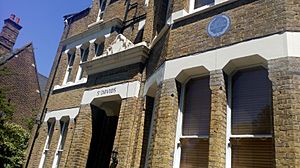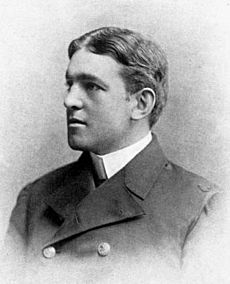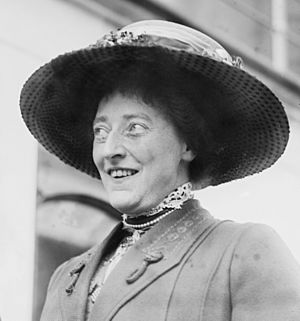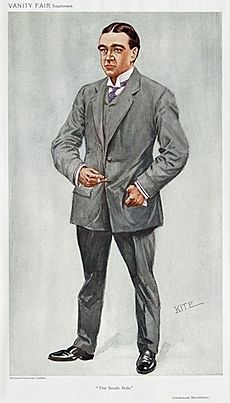Ernest Shackleton facts for kids
Quick facts for kids
Sir
Ernest Shackleton
|
|
|---|---|
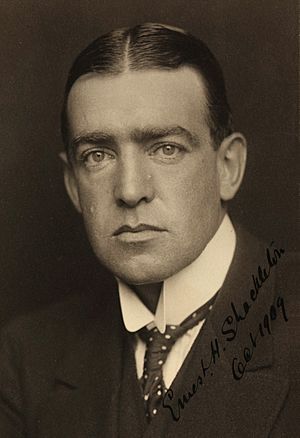
Shackleton in 1904
|
|
| Secretary of the Royal Scottish Geographical Society | |
| In office 11 January 1904 – 10 November 1905 |
|
| Preceded by | Frederick Marshman Bailey |
| Succeeded by | William Lachlan Forbes |
| Personal details | |
| Born |
Ernest Henry Shackleton
15 February 1874 Kilkea, County Kildare, Ireland |
| Died | 5 January 1922 (aged 47) Grytviken, South Georgia, Falkland Islands Dependencies |
| Spouse |
Emily Dorman
(m. 1904) |
| Children |
|
| Relatives | Kathleen Shackleton (sister) |
| Education | Dulwich College |
| Awards |
|
| Signature | |
| Military service | |
| Allegiance | |
| Branch | Royal Navy, British Army |
| Service years | 1901–1907, 1917–1919 |
| Rank |
|
| Wars | |
Sir Ernest Henry Shackleton (born February 15, 1874 – died January 5, 1922) was a famous Anglo-Irish explorer. He led three British trips to the Antarctic, a very cold continent at the South Pole. He was one of the main people during a time called the Heroic Age of Antarctic Exploration, when many brave explorers went to the South Pole.
Contents
Early Life and Dreams
Ernest Shackleton was born on February 15, 1874, in Kilkea, Ireland. His father, Henry Shackleton, wanted to join the army but couldn't because he was not healthy enough. So, he became a farmer. Ernest's mother was Henrietta Letitia Sophia Gavan. Ernest was the second of their ten children.
In 1880, when Ernest was six, his family moved to Dublin. Four years later, they moved again to Sydenham in London, England.
From a young age, Ernest loved to read. This made him dream of adventures. He was taught at home until he was eleven. Then he went to a school called Fir Lodge Preparatory School. At thirteen, he went to Dulwich College. Ernest didn't really like school and found his studies "boring."
He once said that he didn't learn much geography at school. He felt that teachers should be careful not to make learning poetry feel like a chore. Even though he didn't love school, he still did quite well in his final year.
Starting a Career at Sea
Ernest was restless at school, so he was allowed to leave at 16 to work on ships. He chose to become an apprentice on a sailing ship. His father helped him get a spot on the Hoghton Tower, a large sailing ship.
For the next four years, Shackleton learned how to be a sailor. He traveled all over the world and met many different kinds of people. He learned to get along with everyone. Two years later, he became a first mate. In 1898, he became a master mariner. This meant he could command any British ship anywhere in the world.
In 1901, he joined the Discovery expedition as a third officer. He also became a sub-lieutenant in the Royal Naval Reserve.
The Discovery Expedition (1901–1903)
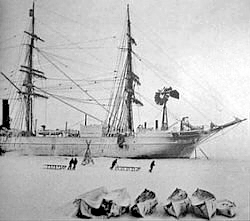
The Discovery Expedition was a British trip to the Antarctic. It was led by Robert Falcon Scott. The main goals were to discover new scientific facts and explore new places.
Shackleton was very popular with the crew. Scott chose him to go on a long journey south with two other men, Edward Wilson and himself. They wanted to reach the furthest point south possible. This journey was not meant to reach the South Pole itself, but to go as far as they could.
They started their journey on November 2, 1902. They reached a new record for the furthest south, at 82° 17' latitude. This was further than anyone had gone before. However, the journey was very hard. Their dogs got sick because their food was bad, and all 22 dogs died. The three men suffered from snow blindness, frostbite, and a disease called scurvy. On the way back, Shackleton became very ill and could not do his share of the work.
On February 4, 1903, they finally reached their ship. Scott decided to send Shackleton home on a ship called the Morning. Scott said Shackleton was too sick to continue.
On April 9, 1904, Ernest married Emily Dorman. They had three children: Raymond, Cecily, and Edward. Edward also became an explorer.
The Nimrod Expedition (1907–1909)
In February 1907, Shackleton shared his plans for a new Antarctic trip. It was called the Nimrod Expedition. His goal was to reach both the geographical South Pole and the South Magnetic Pole. Shackleton worked hard to get money for his trip from wealthy friends.
On August 4, 1907, Shackleton received an honor called the Royal Victorian Order.
On January 1, 1908, the ship Nimrod left New Zealand. Shackleton and three friends—Frank Wild, Eric Marshall, and Jameson Adams—started their "Great Southern Journey" on October 29, 1908. On January 9, 1909, they reached a new furthest south point, only 112 miles (180 km) from the South Pole.
On this journey, they discovered the Beardmore Glacier. They were also the first people to see and travel on the South Polar Plateau. Their trip back to the ship was a race against hunger. They had only half their normal food for much of the way. Shackleton even gave his only biscuit for the day to Frank Wild, who was very sick. Wild wrote in his diary that he would never forget Shackleton's kindness. They reached their base just in time to catch the ship.
Other successes of this trip included climbing Mount Erebus for the first time. They also found the location of the South Magnetic Pole. Shackleton returned to the United Kingdom as a hero. He wrote a book about his trip called Heart of the Antarctic. His wife, Emily, later said that when he didn't reach the Pole, he told her: "a live donkey is better than a dead lion, isn't it?"
In 1910, Shackleton made three recordings about his expedition using an early sound machine. In 2010, some old cases of whisky and brandy left behind in 1909 were found.
A Public Hero
When Shackleton returned home, he received many honors. King Edward VII met him and made him a Commander of the Royal Victorian Order. He was also made a knight, so he became Sir Ernest Shackleton. The Royal Geographical Society gave him a gold medal. All the members of his team also received silver Polar Medals.
People in Britain were very excited about Shackleton's achievements. They admired his courage and strength. People in Ireland also celebrated him, calling him an "Irishman" who almost reached the South Pole.
Other famous explorers also praised him. Roald Amundsen, who was the first to reach the South Pole, said that Shackleton had won a victory that could never be beaten. Even though he was a hero, Shackleton was deeply in debt from his expedition. The government had to give him money to help pay off his most urgent bills.
The Imperial Trans-Antarctic Expedition (1914–1917)
In 1914, Shackleton announced his new big trip, called the "Imperial Trans-Antarctic Expedition." He planned to cross the entire Antarctic continent. Two ships would be used. The Endurance would take the main team to the Weddell Sea. From there, Shackleton and five others would start their journey across the continent. Another ship, the Aurora, would take a support team to the other side of Antarctica. This team would set up supply stops with food and fuel. These supplies would help Shackleton's team finish their 1,800-mile (2,900 km) journey.
Shackleton was very good at raising money. Most of the expedition was paid for by private donations. The British government also gave some money.
But disaster struck! The Endurance got stuck in thick ice. The crew spent 281 days on board, hoping the ice would break. But the ship was slowly crushed to pieces by the ice. Shackleton and his men had to drag their small lifeboats many miles across the snow and ice to reach open water. They then sailed in the lifeboats and finally reached Elephant Island.
In April 1916, Shackleton and four others took one of the lifeboats, the James Caird, and sailed hundreds of miles to South Georgia. They hoped to get help at a whaling station there. This was a journey of about 800 miles (1,300 km) and took 16 days. When they landed on South Georgia, they were on the wrong side of the island. They had to climb over the tall, icy mountains to reach the whaling station. A rescue team saved everyone from Elephant Island in August 1916. All 28 men survived this incredible journey.
Last Expedition and Death
Shackleton later wrote a book about the Endurance expedition called South. In 1920, he decided he wanted to go on one last expedition. He first thought about exploring the Arctic. He got some interest from the Canadian government. With money from a school friend, John Quiller Rowett, he bought a ship called Quest.
His plans changed, and he decided to go back to the Antarctic. The goals for this trip were not very clear. He talked about sailing around the Antarctic continent and exploring some "lost" islands.
Rowett agreed to pay for the whole trip, which became known as the Shackleton–Rowett Expedition. On September 24, 1921, the expedition left England.
Even though some of his old crew members had not been fully paid from the Endurance trip, many of them joined him again. When the ship arrived in Rio de Janeiro, Shackleton had what seemed like a heart attack. He refused to see a doctor. The Quest continued south, and on January 4, 1922, they reached South Georgia.

Early the next morning, January 5, 1922, Shackleton called the ship's doctor, Alexander Macklin. He was complaining of back pains. Macklin told him he was working too hard and should live a more relaxed life. Shackleton asked, "You are always wanting me to give up things, what is it I ought to give up?" A few moments later, at 2:50 a.m., Shackleton had a fatal heart attack and died.
Some studies of old diaries suggest that Shackleton might have had a "hole in the heart" from birth. This could have caused his health problems.
Shackleton was buried in Grytviken, South Georgia. In 2011, the ashes of Frank Wild, Shackleton's close friend and "right-hand man," were also buried next to him.
Shackleton's Legacy
Early Recognition
Before Shackleton's body was returned to South Georgia, a special service was held for him in Montevideo. Another service was held in St Paul's Cathedral, London. The King and royal family were represented there. A year later, the first book about his life was published. This book also helped his family, as Shackleton had died with many debts. A special fund was also set up to help educate his children and support his mother.
For many years, Captain Scott was seen as a bigger polar hero than Shackleton. Scott had more than 30 monuments in Britain. A statue of Shackleton was put up in London in 1932, but there were not many other public memorials for him. Books also focused more on Scott.
Later Fame
In 1959, a book called Endurance: Shackleton's Incredible Voyage was published. This was the first of many books that showed Shackleton in a very positive way. At the same time, people started to look at Captain Scott more critically. Soon, Shackleton became much more popular than Scott. In a 2002 BBC poll for the "100 Greatest Britons", Shackleton was ranked 11th, while Scott was 54th.
In 1983, the BBC made a TV show called Shackleton. In 2001, some writers used Shackleton as an example of a great leader for businesses. They said his way of leading, which focused on people, could help anyone in charge. Other writers also used Shackleton as a model for bringing order out of chaos.
Many universities now teach about Shackleton's leadership. The US Navy also uses him as a model leader. In 2001, the Shackleton Museum in Ireland started an annual school to honor his memory.
Shackleton's death marked the end of the Heroic Age of Antarctic Exploration. This was a time of great discovery in Antarctica, without modern travel or radio. A fellow explorer once wrote that if he was in a lot of trouble and needed to get out, he would choose Shackleton every time.
In 1993, Trevor Potts recreated Shackleton's famous boat journey from Elephant Island to South Georgia. He used a copy of the James Caird. In 2002, a TV show called Shackleton was made in the UK, starring Kenneth Branagh. It showed the 1914 expedition.
In 2011, a biscuit that Shackleton gave to a hungry friend on his 1907 trip sold for £1250 at an auction. That same year, Google honored him with a Google Doodle on his birthday. An asteroid was also named 289586 Shackleton in his memory.
In January 2013, a British-Australian team repeated Shackleton's 1916 journey across the Southern Ocean. They used a replica of the James Caird and old-fashioned gear. They were the first to successfully repeat both the boat journey and the mountain crossing on South Georgia. This trip was made into a documentary film.
In 2015, Shackleton's medals were sold at auction for a lot of money. In 2016, Shackleton was featured on a series of UK postage stamps. A new statue of him was also put up in Athy, Ireland. In 2017, a musical play about him called Ernest Shackleton Loves Me opened in New York City.
Awards and Decorations
|
British Honors
|
Other Honors
|
Family Coat of Arms
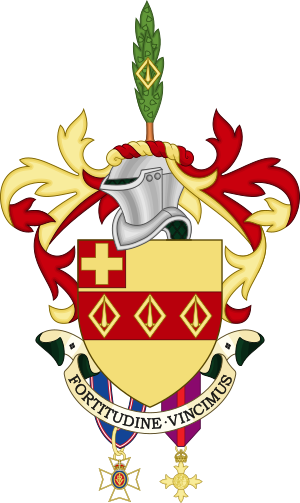 |
|
See also
 In Spanish: Ernest Shackleton para niños
In Spanish: Ernest Shackleton para niños
- Aurora Australis, the first book ever made in Antarctica.
- Avro Shackleton, a British airplane named after him.
- RRS Ernest Shackleton, a research ship.
- Shackleton crater, a crater on the Moon near its south pole.
- Third man factor, a strange feeling some explorers have of an unseen helper during very hard times.


